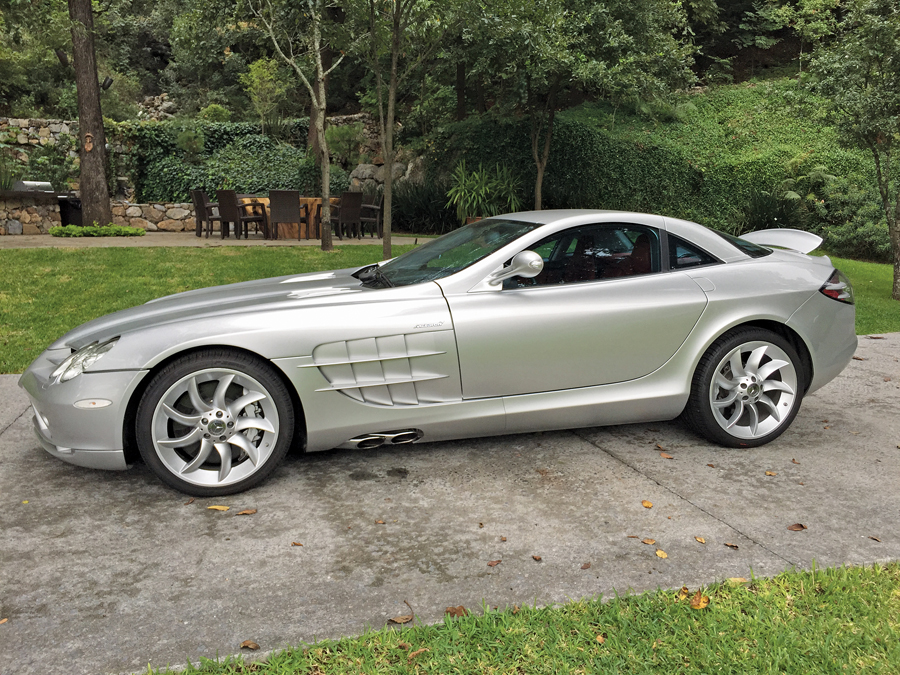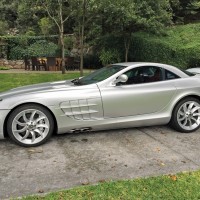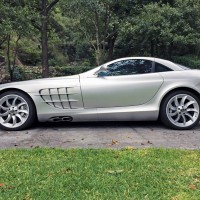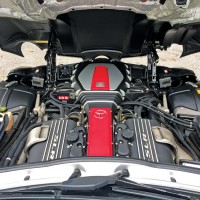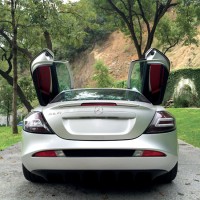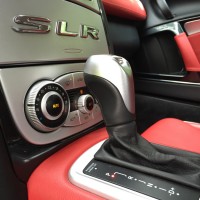SCM Analysis
Detailing
| Vehicle: | 2005 Mercedes-Benz SLR McLaren |
| Years Produced: | 2003–10 |
| Number Produced: | 2,282 |
| Original List Price: | $495,000 (2009 roadster) |
| SCM Valuation: | $195,000–$385,000 |
| Tune Up Cost: | $6,000 |
| Chassis Number Location: | On engine firewall and on radiator support |
| Engine Number Location: | Rear of cylinder block on left side |
| Club Info: | Mercedes-Benz Club of America |
| Website: | http://www.MBCA.org |
| Alternatives: | 2012–14 Mercedes-Benz SL63 AMG, 2004–16 Aston Martin DB9, 2006–12 Ferrari 599 GTB |
| Investment Grade: | D |
This car, Lot 11, sold for $407,000, including buyer’s commission, at Motostalgia’s Grand Prix auction in Austin, TX, on November 7, 2015.
The Mercedes-Benz SLR McLaren was supposed to be quite a car. For some it was the consolation prize in lieu of the CLK-GTR, and for others it was (kind of, sort of) the successor to the McLaren F1. Because it lacked the wild looks of the GTR, and it was simply nothing like the legendary F1, it never generated the lasting impact that Daimler Benz hoped. Anyone who doesn’t know what the SLR is would probably mistake it for an SL550.
The question here is: Does the McLaren name, the eccentric nasal protrusion and the limited production make this a Mercedes with long-term collectability, or is it an overdone French pastry of a car that performs comparably to an SL63 AMG? Note that the SL63 originally sold for much less.
Filet Mignon between white bread
As someone who loves mechanical excellence, I have to admit that the mechanical package of the SLR is magnificent. The supercharged V8 is based on the robust Mercedes M113 engine, and its bespoke engineering cues make it unique to the SLR. It’s a shame it isn’t sitting in the rear of a car that resembles the F1 or the CLK-GTR. Top end is just about 200 mph, with 0–60 mph acceleration in less than 3.5 seconds.
However, a supercar needs to look outrageous. If Mercedes had followed the lead of the Ford GT, the Porsche Carrera GT or the Bugatti Veyron, the SLR would have sold the anticipated 5,000 units.
Its most innocuous design attribute was the fact it emulated a production Mercedes. It strongly resembles the AMG R230 SLs. Because the SLR didn’t bring a completely new visual package to the table, it did not have the supercar effect. Mercedes has a tendency to manufacture automotive forms with conservative design principles — while withholding their exciting prototypes (think C111 and C112) from production.
How long until the milk spoils?
One of the perks of dealing with modern Mercedes is the inevitable failure of their electronic controls. I have seen various columnists speculate about this issue, but I’m going to tell you bluntly: Mercedes-Benz electronics from this era are fragile, nearly impossible to repair (believe me, I am being optimistic) and will not be reissued like parts for the W113 or W107 SLs. The SLR, or any Mercedes product from this era, will swarm with calamities once the various modules fail and its CAN wiring begins to biodegrade.
While some very enthusiastic electrical engineering student may come up with repairs for various circuit-board failures, once the wiring dies off, you have a yard ornament. And even now, finding a dealer tech at any Mercedes service facility that can repair this car, diagnose its electronic trouble codes and get to the root of its issues will be a challenge.
If you want an example, consider the SLR’s electronic spoiler that elevates at about 75 mph. This is a great example of technology that almost no one will be able to service in 10 years when it starts acting up.
Not a race car or the Uhlenhaut coupe
When Mercedes starts building different limited editions of a limited production car, it shows how desperate they are to move it. In the beginning, the advertising department said this car was meant to follow in the footsteps of Rudi Uhlenhaut’s 300SLR. I’m assuming any SCM reader who appreciates Mercedes knows about Herr Uhlenhaut, but if you don’t, look him up.
The street car that is most like the 300SLR is the 300SL coupe with an alloy body and NSL cam. The SLR McLaren is to the 300SLR as a cubic zirconia is to a real diamond.
Just like there are people who will pay lots of money for Beanie Babies and Matchbox cars, there are those who will buy pickled SLR 722 edition cars for top money. The SLR 722 edition was Mercedes’ attempt at making the SLR look cool and outrageous by cutting the roof off. I had a friend from the U.K. who did this to Morris Marinas, and everyone noticed him, too — but only for driving a car without a roof or windscreen of any sort.
Classic Mercedes are better investments
The real-world market for an SLR coupe lies in the $200k–$300k range with a few outliers. These cars were almost never driven when new, and most of them have about 10,000 miles.
They sold for about $500k new, which means they have lost around 50% of their value since, but it is really too soon to tell. If you happen to like the SLR and want to own one, make sure you own the following collectible Mercedes-Benz cars first: a real 300SL (if you can afford it), a solid W113 280SL, something interesting like a 500SLC and a modern SL55 AMG to use as a beater. The SLR should be viewed as a depreciating toy and not as an investment. If you’re buying for the mechanical thrills, your heart is in the right place.
I take my hat off to Motostalgia for selling an SLR for this kind of money. I would love to see what they can do with a Mercedes that has long-term appreciation in its future. ♦
(Introductory description courtesy of Motostalgia.)
